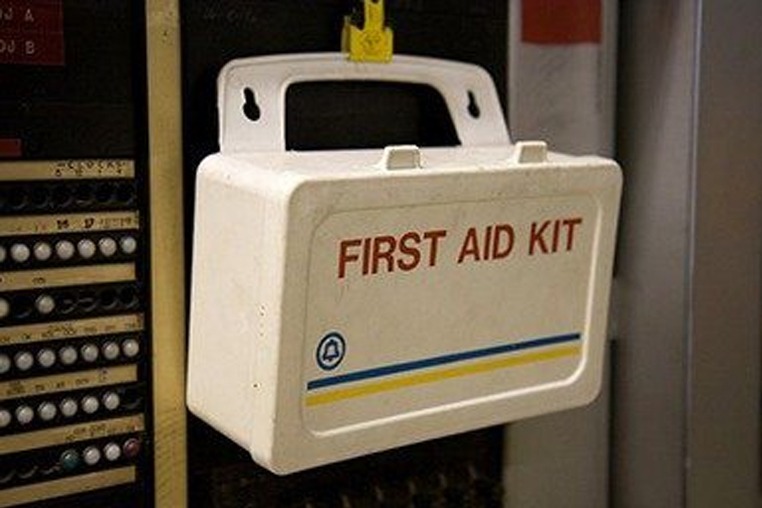First Aid Course in Canberra. Nationally Recognised Training. Excellent Provider. Free First Aid Manual. Book a First Aid Course Today!
It’s summer and that means lots of people will be hitting the trails and embarking on long hikes. Many will even bring along their favorite four-legged friend. While dogs may enjoy running carefree through the woods and sniffing everything they come across, there are several things owners should do to make sure their dog has a safe and pleasant hike. For starters, make sure your dog is physically ready for such an outing and gather all your other gear.
It’s essential that owners also pack a first aid kid and know how to treat common injuries before taking a dog on a hike, according to Dr. Nina Anderson, medical director of Buckhead Animal Clinic. Anderson answers some common questions regarding first aid for dogs, what steps to take for treating injuries and preventative tips so you can avoid the negative scenarios.
What should you pack for a first aid kit specifically meant for a dog?
There is a lot of overlap, including betadine or peroxide to clean wounds, tweezers, ace bandage, gauze pads, eye wash, medical tape. I would add Benadryl for insect bites. I recommend checking with your vet for appropriate doses and that’s not contraindicated due to individual health. There is a product, Tuf-Foot, that can help cuts. (I haven’t personally used it).
 Make sure your dog drinks plenty of water before a hike and frequently throughout the day. (Photo: ArtifyAnalog/Shutterstock)
Make sure your dog drinks plenty of water before a hike and frequently throughout the day. (Photo: ArtifyAnalog/Shutterstock)
How much water should a dog drink while hiking?
A lot! Train your dog on short walks to drink from a foldable bowl or a water bottle with an attachment so they can drink well before a long hike. Many short water breaks are much better than a big belly full of water.
Is it OK for dogs to wear packs while hiking?
Yes, but carry 10-15 percent of body weight only. Make sure you have trained with your dog on shorter walks to make sure there aren’t pressure sores or chaffing. The weight may change the balance/weight on the dog’s legs, so practice is important. Age, size, breed and athleticism plays into if a pack is appropriate. The human hiker should plan to carry the majority of the supplies!
Is a retractable or short leash better suited for hiking?
NO retractable leashes! So many problems will be avoided if on a short leash — problems with other dogs, people, wild animals, eating plants away from humans, avoiding snakes, etc.
Are certain types of treats better tailored to give a dog energy and proper sustenance while hiking?
Protein treats and plenty of water. If hiking for many hours, expect that dogs will need to increase the volume of their food. Multiple smaller meals are better than abruptly giving the dog a much bigger meal on an empty stomach. If you’re hiking a lot, discuss with your vet about the best-suited food for your dog’s level of exercise and lifestyle.
 Anderson recommends not taking short-muzzled dogs on hikes. (Photo: ltummy/Shutterstock)
Anderson recommends not taking short-muzzled dogs on hikes. (Photo: ltummy/Shutterstock)
Listed below are injuries a dog may sustain while hiking, and Anderson provides steps for treating each of them:
- Insect bite/sting: Use a tweezer to remove stinger, clean with betadine and use your antihistamine. (Discuss the proper dosage with your vet before you go.)
- Sprained/strained ankle/paw: Place an ice pack on the sprain and slow down. If your pet is small enough, carry him. Do not splint the hurt leg.
- Foot pad cut (and other cuts): Clean with betadine and use foot protection if you have it. But again, you have to train with the dog first to make sure the booties are comfortable and fit well.
- Eating unknown plant/mushroom/etc: Ask your vet for the appropriate dose for making you dog vomit. Peroxide usually works.
- Snake bite (other venomous animal bite): Get to vet ASAP.
- Broken bone: Just like for human hikers, this is the end of the hike. Get help! Carry your dog or head back at a very slow pace with your dog.
- Heat exhaustion/stroke: Cool down. Do not hike with pugs, bulldogs, Frenchies or other short-muzzled dogs. It’s super important to hike in cool weather and shade and take breaks. Training to get your dog adjusted to hiking is even more important than with humans. Overweight and long-haired dogs will have a harder time. Drink cool water in small amounts, wet their fur, feet and face, get in the shade and get to the vet ASAP, as this can be deadly.
- Ticks: Use flea and tick preventative medication as directed by your veterinarian all year-round.
- Ripped dew claw: Clean with betadine and use a light bandage, making sure it’s not too tight to create tourniquet action that would cause foot to swell and pool blood in the foot.
- Allergic reaction: Use antihistamine dose previously discussed with your vet.
Book in to a first aid course with Canberra First Aid at www.canberrafirstaid.com

